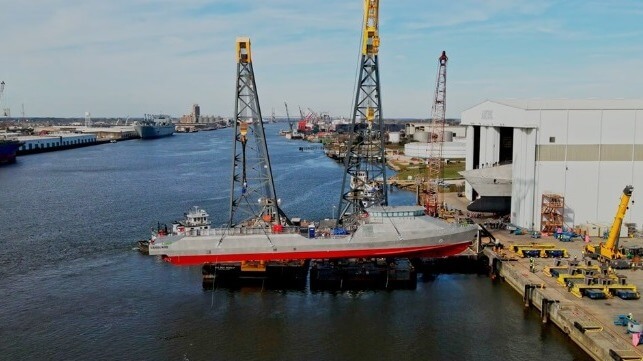U.S. Navy Launches its First Purpose-Built Midsize USV

Austal USA has launched the U.S. Navy's first purpose-built midsize unmanned vessel, Vanguard, Naval Sea Systems Command announced last week.
Vanguard is the third in a series of USV testbeds based on a commercial crewboat design. Vanguard is the first built from the keel up for this purpose; the first two were converted from existing vessels. The hull was launched on December 13, but NAVSEA delayed the announcement until January 11. Outfitting is still under way under the guidance of Austal and defense contractor L3Harris.
The program is an extension of the "Operation Overlord" experiment, a joint Pentagon-Navy development project, and the Navy refers to the vessels as "Overlord USVs," or OUSVs. According to program manager Capt. Scot Searles, Vanguard will have "new, built-in capabilities that our previous OUSVs did not possess." When the vessel is completed, it will make the trip to San Diego to join near-sister ships Ranger and Mariner, which have just returned from a five-month transpacific voyage.
The results of that voyage are promising, Searles told defense media on Tuesday. In August, Ranger and Mariner deployed to the Western Pacific with Sea Hunter and Seahawk, a pair of smaller trimaran USVs. The four vessels sailed a combined 46,000 nautical miles, and stayed in autonomous mode almost all of the time. Human crews were on hand to intervene when needed, but this was infrequent, he told USNI. About once every two weeks, an intervention would be required for one of the ship's systems, whether mechanical systems, comms links or autonomy systems.
The autonomy suite only had to be deactivated 13 times for all four vessels over that time period. “We’re having to actually have a human step in and correct the autonomy less than one time per month," Searles told USNI.
For the future Large USV (LUSV) program, Congress has required the Navy to demonstrate that certain key mechanical systems can operate for 30 days without human intervention. This includes a 720-hour "no-touch" continuous run requirement for the diesel generator. The first land-based test for a popular commercial engine model was completed in December, and it "demonstrated sufficient mechanical reliability."
LUSV's mission is to serve as a magazine ship, essentially an extension of a destroyer's missile carrying capacity. It will be a 1,500-ton vessel, far smaller than a conventional surface combatant, saving cost while expanding the service's vertical launch cell count.
